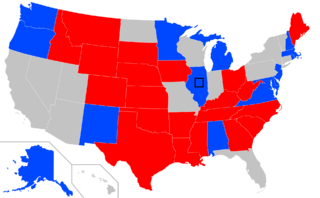2020 United States Senate Elections (LOTF RP)
| ||||||||||||||||||||||||||||
36 of the 100 seats in the United States Senate 51 seats needed for a majority | ||||||||||||||||||||||||||||
|---|---|---|---|---|---|---|---|---|---|---|---|---|---|---|---|---|---|---|---|---|---|---|---|---|---|---|---|---|
| ||||||||||||||||||||||||||||
 Results of the elections: Democratic gain Republican gain Democratic hold Republican hold Result undetermined No election Rectangular inset (Il.): both seats contested | ||||||||||||||||||||||||||||
| ||||||||||||||||||||||||||||
The 2020 United States Senate elections will be held on November 3, 2020, with the 33 class 2 seats of the Senate contested in regular elections. The winners will be elected to six-year terms extending from January 3, 2021, to January 3, 2027. There will also be three special elections: one in each of Illinois, Ohio and Maryland. All were brought on by the early resignation of the incumbent Senators.
In the 2014 United States Senate elections (the last regularly scheduled elections for class 2 Senate seats), the Republicans won eight seats from the Democrats and gained a majority in the Senate, which they successfully defended in 2016 and 2018. Following the Republican defeat in the 2019 Texas U.S. Senate special election, Republicans hold 52 seats entering this election. Republicans will be defending 20 seats, while Democrats will be defending 15.
Democrats need to net a gain of three seats or two seats and the Vice-Presidency in the concurrent Presidential Election to win a majority.
Competitive Races
Competitive Republican held seats are expected to be Colorado, Ohio, Maine, Iowa and North Carolina. Georgia, Montana and Texas could also become competitive. Competitive Democratic held seats are expected to be in Alabama, Alaska, Michigan and New Hampshire. New Mexico, Minnesota and Virginia could also become competitive.
Alabama
Alaska
Arkansas
Colorado
Delaware
Georgia
Idaho
Illinois
Illinois (Regular)
Illinois (Special)
Iowa
Kansas
Kentucky
Louisiana
Maine
Massachusetts
Michigan
Minnesota
Mississippi
Montana
Nebraska
New Hampshire
New Jersey
New Mexico
North Carolina
Oklahoma
Oregon
Rhode Island
South Carolina
South Dakota
Tennessee
Texas
Virginia
West Virginia
Wyoming
Notes
- ↑ 1.0 1.1 Republicans lost the 2019 United States Senate special election in Texas to Democratic candidate Suraj Shah